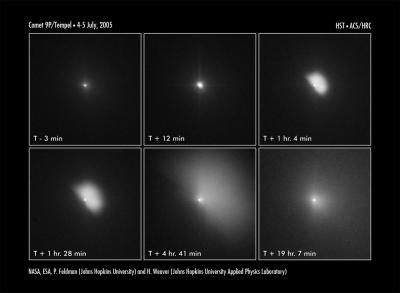The Hubble images below (click to enlarge) give an idea of the size of the Deep Impact event. At left is the comet Tempel 1 before the collision. In the middle image, taken 15 minutes after impact, the comet is four times brighter than before and shows a substantially increased cloud of dust and gas. The image at far right was taken over an hour after the collision. Note the fan shape of the ejecta — the debris, according to this Hubble news release, is pushing outward at about 1800 kilometers per hour.

Image: The potato-shaped comet is 14 kilometres wide and 4 kilometres long. Tempel 1’s nucleus is too small even for the Hubble telescope to resolve. These visible-light images were taken by the Advanced Camera for Surveys’ High Resolution Camera. Credit: NASA, ESA, and the Hubble Heritage Team (STScI/AURA).
Data from Deep Impact continue to accumulate. Images taken by ESA’s XMM-Newton observatory (an x-ray observatory based in space) show the emissions of hydroxyl ions, the direct decay product of water. 90 minutes after the impact, the brightness of the hydroxyl groups had increased by a factor of five; some 4.5 hours later, the emissions had again decreased. The confirmation of water on Tempel 1 backs up earlier observations of the comet by ESA’s Rosetta spacecraft. ESA offers the XMM-Newton images here.
NASA’s Swift satellite (normally used for detecting gamma ray bursts and creating a map of x-ray sources in the universe) provided the only multi-wavelength observation of the Deep Impact event. Working in optical, ultraviolet, x-rays and gamma rays, the satellite saw a quick rise in ultraviolet light consistent with Deep Impact striking a hard surface, as opposed to a softer, snowy one. Swift images are also available online in a Penn State news release from which the following is quoted:
“Some called it fireworks today, but it really was more like ‘iceworks,'” said Prof. Keith Mason, Director of Mullard Space Science Laboratory at University College London, who organized the Swift observations. “Much of the comet is ice. It’s the other stuff deep inside we’re most interested in — pristine material from the formation of the solar system locked safely below the comet’s frozen surface. We don’t know exactly what we kicked up yet.”
Observatories in space and on Earth will continue to monitor Tempel 1 in the following week as data from the collision are analyzed. The debris observed in ultraviolet light is the result of an icy surface suddenly being heated to 2000 degrees F by the impact. To this point, x-rays have not been detected, but are expected to appear when sub-surface material lifts into the comet’s coma and is illuminated by the high-energy solar wind from the Sun.
And I love this AP story out of Moscow: a Russian astrologer by the name of Marina Bai has sued NASA on the grounds that the Deep Impact probe has caused astrological damage. Running a spacecraft into a comet, said the astrologer, “…ruins the natural balance of forces in the universe,” according to the newspaper Izvestia. She had earlier told the paper that Deep Impact would “…deform her horoscope.”

